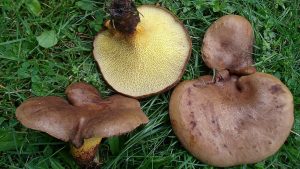#080: Flavoparmelia caperata, The Common Greenshield Lichen
One of the most common lichens in North America, the Common Greenshield looks a lot like a leaf of lettuce glued to a tree.
Late winter is probably the worst time of year for a mushroom hunter. The winter mushrooms have mostly finished fruiting and the morels remain in hiding for another month or so. On the upside, this dearth of mushrooms forces one to appreciate the often overlooked fungi: woody fruiting bodies from bland Trametes species, jelly fungi that produce squishy but resilient mushrooms, and all the little lichens hiding in plain sight. With the weather climbing above freezing and the trees mostly bare, now is a great time to get out and look for lichens! Lichens quickly rejuvenate when water is available, so after it rains or once the snow begins to melt, keep an eye out for their bright greens, oranges, and reds as well as their dark grays and browns.
Today, I would like to introduce you to one of the most common lichens in North America: the Common Greenshield. This lichen is composed of the fungus Flavoparmelia caperata (Ascomycota, Lecanoromycetes, Lecanorales, Parmeliaceae) and a green alga (kingdom Plantae). The fungus is the dominant partner in the symbiosis, so the lichen’s name is the same as that of the fungus. The Common Greenshield is fairly easy to spot: it looks somewhat like a leaf of lettuce glued to the side of a tree. Its upper surface is usually pale yellow-green, but it becomes a deeper green when wet. The edges of the Common Greenshield are broken up into rounded lobes. These lobes are smooth when the lichen is small, but soon become wrinkled in medium to large specimens. Towards the center of the lichen, you will notice irregular rough patches. These rough patches are actually the reproductive structures of the lichen. Each bump (or “pustule”) produces powdery “soredia,” which consist of algal cells wrapped in fungal hyphae. These are distributed by the wind to produce new lichens asexually. Other types of reproductive structures are rarely seen on the Common Greenshield. If your lichen has distinctive discs on its surface, it’s most likely a different species of lichen. The Common Greenshield can be found on any surface, but it prefers bark and wood. Luckily for those of you who live in cities, this lichen is relatively tolerant of pollution (in comparison to other lichens). I encourage you to try and find it in your neighborhood.
Now that you can find the Common Greenshield, what can you do with it? Today, one of the most useful things you can use this lichen for is to help assess air pollution. Lichens as a whole are very sensitive to pollution. Therefore, the more lichens you can find, the cleaner the air is. Likewise, the greater number of lichen species you can find, the cleaner the air is. The Common Greenshield is less sensitive to pollution than most lichens, so it will likely be one of the few species you find in moderately polluted areas. Long before anyone was concerned about air pollution, people came up with a couple other uses for this fungus. The Tarahumar people of northern Mexico ground the lichen into a powder that was used to treat burns. On the Isle of Man, the lichen was used to dye wool. Dye made from the Common Greenshield imparts woolen fabrics with a color anywhere from lemon yellow to brown orange.
See Further:
http://www.fcps.edu/islandcreekes/ecology/common_greenshield.htm
http://www.muskokawatershed.org/wp-content/uploads/LichenID.pdf
http://en.wikipedia.org/wiki/Flavoparmelia_caperata
http://blog.mycology.cornell.edu/2011/12/16/the-lichens-of-tower-road/
http://www.lichen.com/bigpix/Fcaperata.html
http://web.uvic.ca/~stucraw/part2AM.html#Flavoparmelia_caperata







![#011: Characteristics of Kingdom Fungi [Archived]](https://www.fungusfactfriday.com/wp-content/themes/hueman/assets/front/img/thumb-small-empty.png)


We have been walking our two year old grandson in his stroller during the pandemic (the only way we can safely spend time with him) and admiring the different things we see along the way. He is very attentive and has been learning to identify pine trees (“evergreen” in winter) by finding the pine cones under them and feeling the sharp pine needles. Thank you for this article about Greenshield lichen. We will be sure to examine the lichen more closely when we find it and talk about this amazing life form with him!